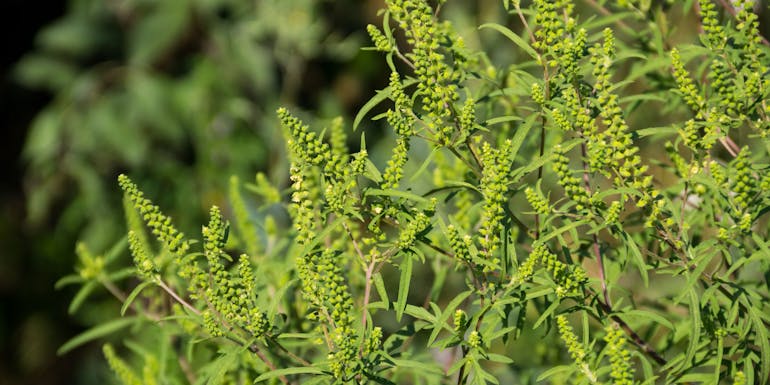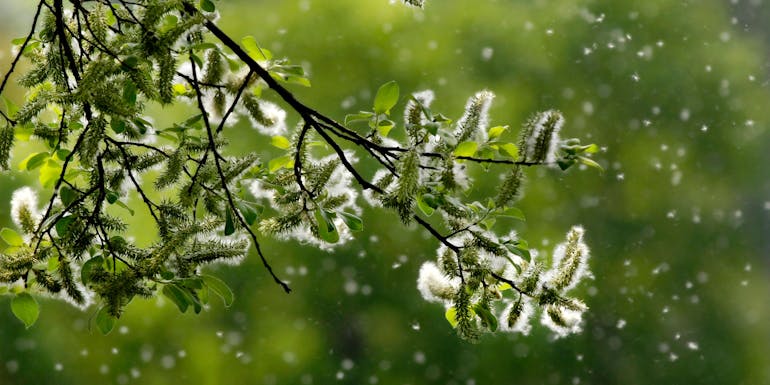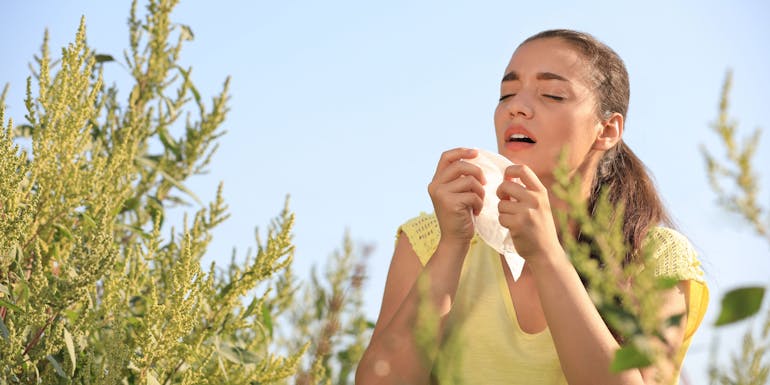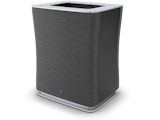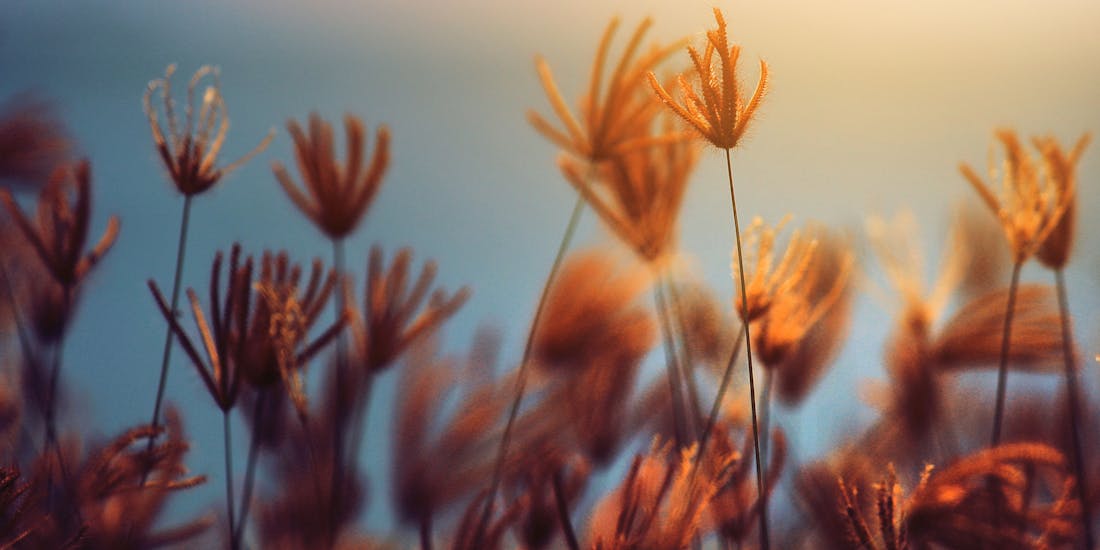
Nadine Walder, 29 August 2025
Healthy air for allergy sufferers
Allergies in autumn: these pollens are still flying
Autumn has many beautiful sides – colourful leaves, cosy evening hours and the soothing crunch of leaves under our feet. However, this time of the year also brings with it autumn allergens that can trigger unpleasant symptoms in sensitive people. Although the main pollen season is in spring and early summer, pollen still fly in autumn. There are also other allergies that can become particularly acute in autumn.
Read on to find out
- Autumn pollen count: mugwort, ragweed and grasses
- The influence of climate change on the pollen count
- More allergies in autumn
- What to do about allergies in autumn?
Autumn pollen count: mugwort, ragweed and grasses
Autumn in Switzerland is not only characterised by golden forests and the smell of fresh apples, pollen also plays an invisible but still significant role in autumn. While most trees and plants have their main pollen season in spring and early summer, some still release pollen in autumn.
Mugwort, which flowers from July to September and often grows along roadsides or in meadows, contributes to the pollen load in autumn. Its small pollen grains float in the cool autumn air and can trigger hay fever symptoms in allergy sufferers.
A particular challenge in autumn is the ragweed plant. According to the aha! Swiss Allergy Centre, its pollen is highly allergenic. This invasive plant species flowers in late summer and autumn and releases large amounts of pollen. Ragweed pollen can fly long distances on the wind because it is very small and light. In Switzerland, the plant is mainly found in Ticino and western Switzerland. For allergy sufferers, even small amounts of ragweed pollen can trigger severe allergic reactions. The symptoms range from nasal congestion, eye irritation and coughing to asthma. Due to its hazardous nature, the plant has had to be officially reported and controlled since 2006.
Grasses also play a role in autumn. Although their main pollen season is in spring, certain grass species still release pollen at this time of the year, which can be unpleasant for allergy sufferers.
These autumnal pollens, from ragweed to mugwort to grasses, can dampen the joy of this time of the year for allergy sufferers. Worryingly, climate change could make this situation worse in the future.
The influence of climate change on the pollen count
According to various studies, the pollen season will lengthen in the next few years due to climate change and the symptoms will become more severe. However, climate change will not only lead to an extension of the pollen season, but also to the fact that new allergy-causing plants will settle in our region.
In an expert interview by the Allergy information service of Helmoltz Munich, Prof. Dr. Jeroen Buters, Director at the Center of Allergy and Environment (ZAUM) in Munich, explains how climate change will alter the pollen count. On the interactive website klimapollen.de you can see which pollen is expected to occur in the future and to what extent. In addition, you can look up on the site when which pollen season begins and how long it lasts. Prof. Dr. Buters emphasises that now the pollen season starts earlier and there is more pollen – but this will not always be the case. For example, in the future it will be so warm that the birch tree will retreat, and the birch pollen load will decrease, says Prof. Dr. Buters. At the same time, warmer temperatures would create optimal conditions for other plants to spread – for ragweed, for example. A change will take place in grass pollen; new grass species will spread more pollen.
Regarding the dangerous weed ragweed, a 2017 study found initial estimates that sensitisation to ragweed in Europe will more than double by 2041-2060, from 33 to 77 million people. Another study from 2015 concluded that the spread of ragweed seeds to suitable areas increases pollen concentrations in the air, which may increase the frequency and prevalence of ragweed allergies.
More allergies in autumn
Pollen is not the only allergen that plays a role in autumn. The aha! Swiss Allergy Centre points out that house dust allergies are particularly strong in autumn, when the heating season begins and we spend more time indoors. When the heating season starts, many mites die and their bodies decay. In this process, they release a considerable amount of allergens. With the heating air, these allergens are swirled back into the air and can enter the lungs. The allergens of the house dust mite can cause allergic rhinitis, allergic conjunctivitis, red, itchy eyes, a runny nose and sneezing.
As humidity rises in autumn, indoor mould can also increase. Although moulds can be found in almost any environment all year round, the concentration of mould spores in the outdoor air is highest in summer and autumn. These spores can easily penetrate living spaces and cause respiratory problems, coughing and skin irritations in allergy sufferers.
What to do about allergies in autumn?
There are some common tips to prevent allergy symptoms in autumn. Living spaces should be ventilated regularly, and the best way to do this is to ventilate intermittently. To prevent indoor humidity and mould from spreading, keep the relative humidity between 40 % and 60 %. You should also change your bed linen regularly and wash it at 60 degrees C.
When it comes to pollen, you should always check the pollen forecast for your region. In our article "10 tips against pollen allergy", we give you detailed tips on how you can prevent and alleviate the symptoms of pollen allergy.
An effective way to relieve allergy symptoms in autumn is to use an air purifier. These devices can help filter allergens such as pollen, mould spores and dust mites from the air, which reduces the burden on allergy sufferers. Air washers are also particularly recommended for allergy sufferers because they optimally wash pollen out of the air and ensure a healthy indoor climate due to the additional humidity, especially in dry room air. Air purifiers with HEPA filters are particularly effective at removing particles. In autumn, the use of air purifiers or air washers in bedrooms and other frequently used rooms can help to improve the air quality and increase the quality of life for allergy sufferers.
Overall, autumn is a beautiful season, but it also brings allergy challenges. However, by understanding the different allergies that can occur at this time of the year and using air purifiers and air washers, allergy sufferers can enjoy a better quality of life and enjoy the joys of autumn to the fullest.
You can find out more about pollen allergies and healthy air for allergy sufferers on our information page. There you will find interesting articles on topics such as what to do about pollen in the bedroom or how you can reduce allergy symptoms with 10 measures.
More about healthy air for allergy sufferers
If you have questions related to indoor room climate, please get in touch with us. Or subscribe to our newsletter to regularly get informed about current topics regarding indoor climate, experience reports or Stadler Form insights.
